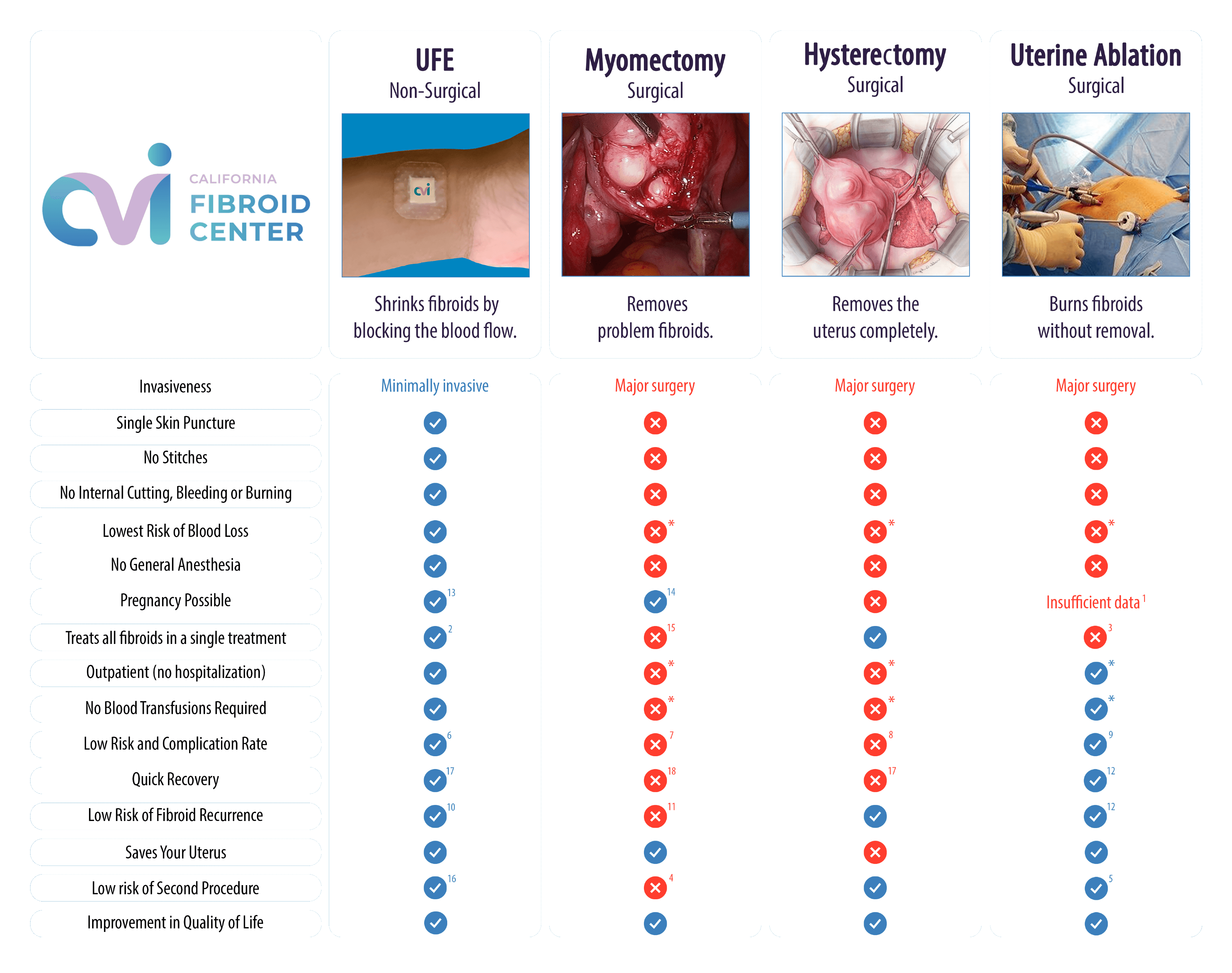
You’re not alone. Nearly 7% of women in the US are living with the debilitating symptoms fibroids.
We are a physician-owned and guided practice. There are no middlemen, hedge-fund companies, or investors affecting how we provide patient care. We have the freedom to make decisions that result in the best experiences and outcomes for our patients. Patient and staff feedback provide the roadmap for the direction of our practice. We invite you to learn more about us!
Sub-specialty fellowship trained. Dual board certified in Vascular & Interventional Radiology and Diagnostic Imaging.
We have a proven track record with over 5,000+ successful image guided procedures and operations.
No rushed visits or overbooking. Local, not national. Multiple ways to connect. We are trusted and transparent.
State of the art tools and advanced techniques. Up to date on latest research and conference.
No sutures. No major incisions. Minimal downtime. Fast relief. Outpatient. Top Rated. What are you waiting for?
No cutting corners. We always put patients first. Contact us today to learn more and find out how we can help!






1. Larger, more rigorous studies are needed to evaluate pregnancy outcome after treatment. Pregnancy has been reported after ablation however, 13% of patients also have reported spontaneous abortions.
2. Certain fibroid subtypes such as those that are avascular or cervical may not respond to treatment. MR imaging can demonstrate the vascularity of fibroids and allow determination of whether embolization is a reasonable treatment option.
3. Numerous fibroids cannot be treated, periphery of large fibroids can grow, fibroids in certain locations require a high level of skill to treat safeley with this method or may require additional procedure such as hysterescopic myomectomy
4. Up to 25% of patients may undergo another procedure after myomectomy
5. Larger follow up studies needed. Reinterventions for fibroid symptoms are reported by company as usually not necessary.
6. Major complication rate is 1.25%.
7. Major complications occur in 43% of patients and minor complications in 32% of patients.
8. Overall complication rates are 51% for total abdominal hysterectomy and 23% for vaginal hysterectomy.
9. Overall complication rate is 2.5% by experienced user.
10. Rate of symptom recurrence is 3% at 1 year post-UFE.
11. Cumulative risk of fibroid recurrence is 10% after one year.
12. 94% of patients feel the treatment was effective in eliminating their symptoms. Recovery time is typically 4-5 days.
13. Spontaneous pregnancy rates after UFE are 40% after two years. For 85.5% of these women, it was their first pregnancy. Other studies have found a subsequent fertility rate of 58% after UFE.
14. Approximately 35% of women conceive after uterine myomectomy.
15. Not every fibroid can be removed during a single myomectomy procedure, this depends on location and technique used. It is not uncommon for women to have multiple myomectomies. For example, only women with submucosal fibroids are eligible for a hysteroscopic myomectomy. Fibroids located within the uterine wall cannot be removed with this technique. Repeat myomectomy is sometimes necessary for recurrent fibroid symptoms and may be associated with postoperative complications and a fertility rate of around 56%.
16. Follow-up studies over several years have shown that it is rare for treated fibroids to regrow or for new fibroids to develop after uterine fibroid embolization. This is because all fibroids present in the uterus, even early-stage nodules that may be too small to see on imaging exams, are treated during the procedure. Uterine fibroid embolization is a more permanent solution than the option of hormonal therapy, because when hormonal treatment is stopped the fibroid tumors usually grow back.
17. Our UFE recovery is 2 days, patients return to work by day 7. UFE reported to have shorter hospital stays (1.71 days versus 5.85 days, P<.01) and faster recovery to physical activities (9.50 days versus 36.18 days, P<.01) than those who had hysterectomies.
18. 60% of patients need less than or equal to 8 weeks and 40% of patients need more than 8 weeks to return to work after laparoscopic uterine myomectomy.
*Depends on technique/operator
1. Jay M. Berman, MD, Abraham Shashoua, MD, Christopher Olson, MD, Sara Brucker, MD, Case Series of Reproductive Outcomes after Laparoscopic
Radiofrequency Ablation of Symptomatic Myomas, The Journal of Minimally Invasive Gynecology, available online at https://acessaprocedure.com/wp-content/uploads/2019/12/Berman-2019-Observational-Study-of-Pregnancy-Post-Acessa-copy.pdf John A. Thiel, MD, and Bala Bhagavath, MD, “
2. Sandeep P. Deshmukh , Carin F. Gonsalves, Flavius F. Guglielmo, Donald G. Mitchell, Role of MR Imaging of Uterine Leiomyomas before and after Embolization, Radiographics available online at https://pubs.rsna.org/doi/10.1148/rg.326125517
3. Lee BB, Yu SP. Radiofrequency Ablation of Uterine Fibroids: a Review. Curr Obstet Gynecol Rep. 2016;5(4):318-324 available online at https://www.ncbi.nlm.nih.gov/pmc/articles/PMC5114324/
4. Lee BB, Yu SP. Radiofrequency Ablation of Uterine Fibroids: a Review. Curr Obstet Gynecol Rep. 2016;5(4):318-324 available online at https://pubmed.ncbi.nlm.nih.gov/17125423/
5. Braun KM, Sheridan M, Latif EZ, et al. Surgeons’ early experience with the Acessa™ procedure: gaining proficiency with new technology. Int J Womens Health. 2016;8:669-675. Published 2016 Nov 23. doi:10.2147/IJWH.S119265 available online at https://www.ncbi.nlm.nih.gov/pmc/articles/PMC5126001/
6. Raikhlin A, Baerlocher MO, Asch MR. Uterine fibroid embolization: CME update for family physicians. Can Fam Physician. 2007;53(2):250-256 available online at https://www.ncbi.nlm.nih.gov/pmc/articles/PMC1949124
7. Adesina KT, Owolabi BO, Raji HO, Olarinoye AO. Abdominal myomectomy: A retrospective review of determinants and outcomes of complications at the University of Ilorin Teaching Hospital, Ilorin, Nigeria. Malawi Med J. 2017;29(1):37-42 available online at https://www.ncbi.nlm.nih.gov/pmc/articles/PMC5442490
8. Al-Kadri HM, Al-Turki HA, Saleh AM. Short and long term complications of abdominal and vaginal hysterectomy for benign disease. Saudi Med J. 2002 Jul;23(7):806-10. PMID: 12174230 available online at https://pubmed.ncbi.nlm.nih.gov/12174230/
9. Braun KM, Sheridan M, Latif EZ, et al. Surgeons’ early experience with the Acessa™ procedure: gaining proficiency with new technology. Int J Womens Health. 2016;8:669-675. Published 2016 Nov 23 available online at https://www.ncbi.nlm.nih.gov/pmc/articles/PMC5126001/
10. Spies JB. Current evidence on uterine embolization for fibroids. Semin Intervent Radiol. 2013;30(4):340-346 available online at https://www.ncbi.nlm.nih.gov/pmc/articles/PMC3835459/
11. Nezhat FR, Roemisch M, Nezhat CH, Seidman DS, Nezhat CR. Recurrence rate after laparoscopic myomectomy. J Am Assoc Gynecol Laparosc. 1998 Aug;5(3):237-40. doi: 10.1016/s1074-3804(98)80025-x. PMID: 9668143 available online at https://pubmed.ncbi.nlm.nih.gov/9668143/
12. Acessa Health Corporate data, FAQ available online at https://acessaprocedure.com/faq/
13. Pisco JM, Duarte M, Bilhim T, Branco J, Cirurgião F, Forjaz M, Fernandes L, Pereira J, Costa N, Pisco JBM, Oliveira AG. Spontaneous Pregnancy with a Live Birth after Conventional and Partial Uterine Fibroid Embolization. Radiology. 2017 Oct;285(1):302-310 available online at https://pubmed.ncbi.nlm.nih.gov/28608747/
14. Begum N, Anwary SA, Alfazzaman M, Sultana P, Banu J, Deeba F, Mahzabin Z, Nahar KN. Pregnancy outcome following myomectomy. Mymensingh Med J. 2015 Jan;24(1):84-8. PMID: 25725672 available online at https://pubmed.ncbi.nlm.nih.gov/25725672
15. J. Frederick, M. Hardie, M. Reid, H. Fletcher, S. Wynter, C. Frederick, Operative morbidity and reproductive outcome in secondary myomectomy: a prospective cohort study, Human Reproduction, Volume 17, Issue 11, November 2002, Pages 2967–2971, available online at https://academic.oup.com/humrep/article/17/11/2967/635326
16. UCSF Health, Myomectomy, available online at https://www.ucsfhealth.org/treatments/myomectomy
16. Radiology info, uterine fibroid embolization. https://www.radiologyinfo.org/en/info.cfm?pg=ufe
17. Raikhlin A, Baerlocher MO, Asch MR. Uterine fibroid embolization: CME update for family physicians. Can Fam Physician. 2007;53(2):250-256 available online at https://www.ncbi.nlm.nih.gov/pmc/articles/PMC1949124
18. Huff KO, Aref-Adib M, Magama Z, Vlachodimitropoulou EK, Oliver R, Odejinmi F. Returning to work after laparoscopic myomectomy: a prospective observational study. Acta Obstet Gynecol Scand. 2018 Jan;97(1):68-73. doi: 10.1111/aogs.13246. Epub 2017 Nov 9. PMID: 29030973 available online at https://pubmed.ncbi.nlm.nih.gov/29030973/
The above information explains what is involved and the possible risks. It is not meant to be a substitute for informed discussion between you and your doctor, but can act as a starting point for such a discussion.
UFE is performed through a single puncture in the arm or leg. Unlike a major surgery, there is a shorter recovery, less pain, less risk and lower complications.
Outpatient procedures require no hospital stay or anesthesia. You get to go home the same day with just a Band-Aid. Get back to your normal everyday routine!
UFE is supported by numerous clinical studies as an effective treatment for fibroids and adenomyosis, and does not interfere with hormones or other organs.
There is no cutting into or removing the uterus so that the uterus remains intact after the procedure, thus women still have a chance at getting pregnant.
At CVI, we take our time with consultations and procedures. Our physician has the freedom to spend as much time as needed with each patient. This is a luxury that is hard to find in most corporate medical practices. We are united with our patients to provide the best care and experience possible.



Call (310) 409 4114 | Text (310) 409 4114 |
After hours (310) 492 4019
consult@cavascular.com
Get answers right away.
(213) 800-0806
Multiple locations for your convenience.

Please note that although we strive to protect and secure our online communications, and use the security measures detailed in our Privacy Policy to protect your information, no data transmitted over the Internet can be guaranteed to be completely secure and no security measures are perfect or impenetrable. If you would like to transmit sensitive information to us, please contact us, without including the sensitive information, to arrange a more secure means of communication. By submitting this form you consent to receive text messages from CVI at the number provided. Msg & data rates may apply. Msg frequency varies. Unsubscribe at any time by replying STOP.
Please note that although we strive to protect and secure our online communications, and use the security measures detailed in our Privacy Policy to protect your information, no data transmitted over the Internet can be guaranteed to be completely secure and no security measures are perfect or impenetrable. If you would like to transmit sensitive information to us, please contact us, without including the sensitive information, to arrange a more secure means of communication. By submitting this form you consent to receive text messages from CVI at the number provided. Msg & data rates may apply. Msg frequency varies. Unsubscribe at any time by replying STOP.